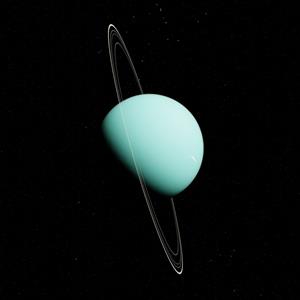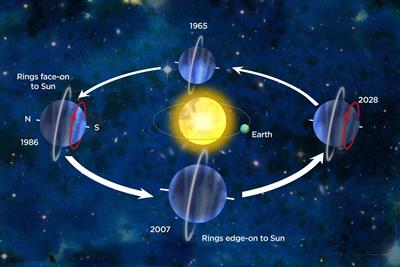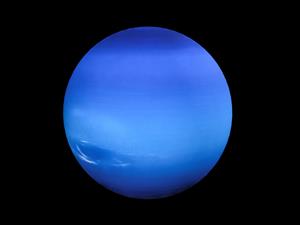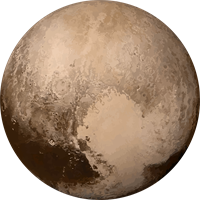
PUMPA - SMART LEARNING
எங்கள் ஆசிரியர்களுடன் 1-ஆன்-1 ஆலோசனை நேரத்தைப் பெறுங்கள். டாப்பர் ஆவதற்கு நாங்கள் பயிற்சி அளிப்போம்
Book Free DemoIn the solar system, the outermost planets are Uranus and Neptune. These two planets are referred to as 'Ice giants'. Uranus and Neptune are near twin in size and surface composition. With the help of large telescopes, these two planets can be observed.The seventh planet, Uranus (Indra), appears blue-green. Being the third biggest giant, Uranus is surrounded by 13 faint rings with 27 natural satellites revolving around it.
Uranus:

Uranus
Unique tilt:
Uranus is similar to Venus in rotating from east to west. It has a highly tilted rotational axis which makes the orbital motion of the planet appear to spin on its side. This unique tilt makes Uranus appear to orbit the Sun like a rolling ball. The period of rotation is 17.2\ hours, and the period of revolution is 84\ years.

Rotation of Uranus around the Sun
Neptune:
The eighth planet, Neptune (Varun), is the farthest in the solar system. This blue colour planet is the only planet which is not visible to the naked eye. This last ice giant is made up of hydrogen and helium in liquid form. No life can exist on this dark, cold planet. It is 3.9 times larger than the Earth. Neptune is the windiest planet with 14 satellites revolving around it. The period of rotation is 16.1\ hours, and the period of revolution is 165\ years.

Neptune
The ninth planet:
There were a total of nine planets in the solar system till 2006. The ninth planet, Pluto, was the farthest planet from the Sun. In 2006, the International Astronomical Union (IAU) framed a new definition and conditions for a celestial object to be a planet. Since Pluto did not satisfy those criteria of a planet, the Union announced was no longer a planet.

Pluto
Dwarf planet:
Pluto is considered a dwarf planet since it does not satisfy the criteria to be a planet. A dwarf planet is not a satellite but a celestial body in a spherical shape. A dwarf planet also follows the same conditions as a planet. The only difference is that the orbit of Pluto does not have a clear neighbourhood. Hence, it is categorised as a dwarf planet.
Reference:
https://live.staticflickr.com/7268/13598076553_054e90b934_b.jpg